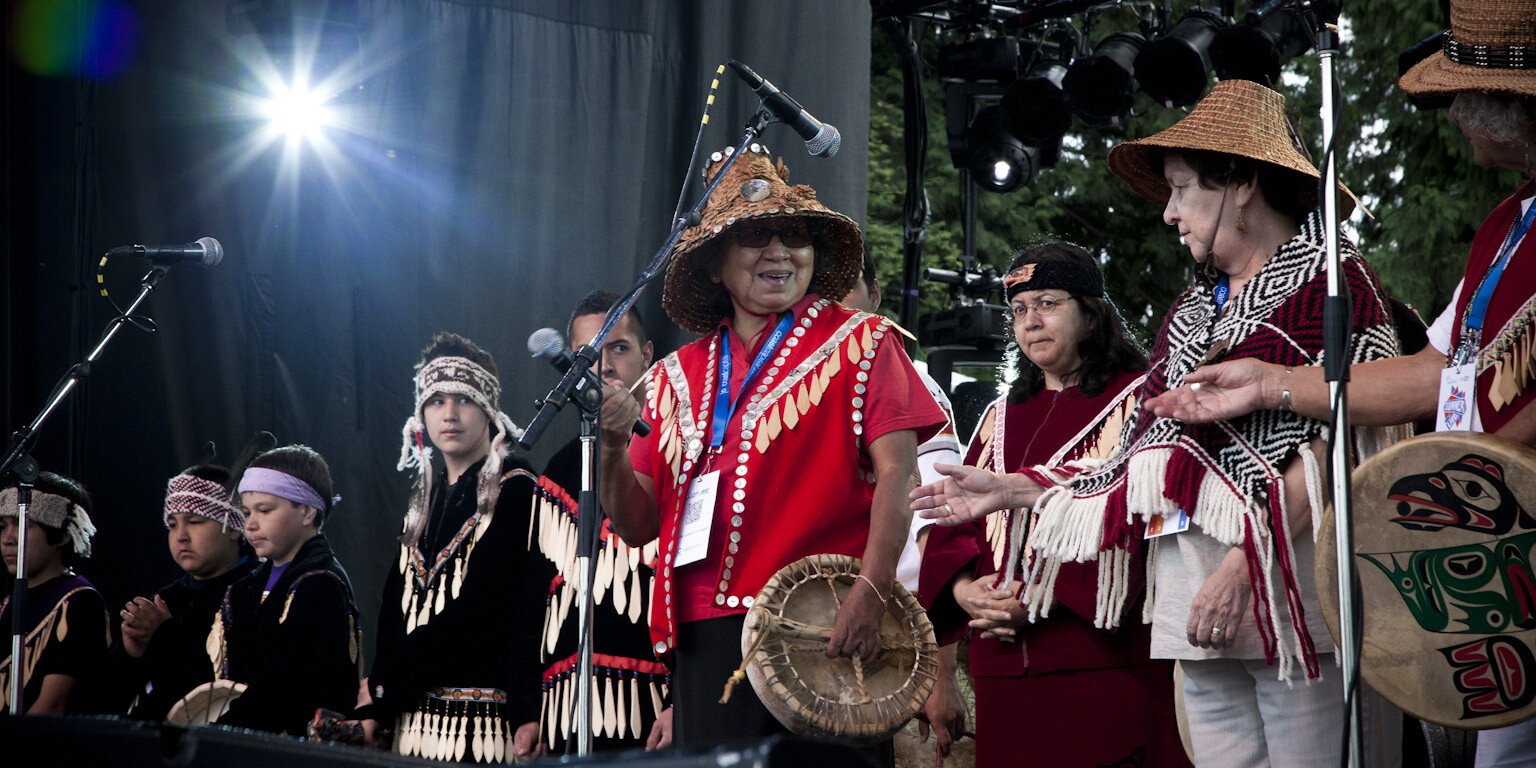Indigenous Peoples Are All the Same, Right?
A frequent misconception is that Indigenous Peoples are all the same in Canada but there is a clear diversity amongst Indigenous Peoples. Linguists...

Language has the power to respect and honour, or, hurt and offend and that is particularly true when working across cultures. Within that frame of reference, we respectfully recommend that when working with Indigenous Peoples you have an understanding of how the historical context of certain phrases can affect your communication and relationships with Indigenous Peoples.
A recommended activity prior to engaging with a community or individual is to do a self-analysis to determine your degree of cultural competency.
For the full checklist, please read the Indigenous cultural competency self-assessment checklist.
Now for some phrases to avoid in your communications:
Avoid usage of “pre-history” as it implies the history of Indigenous Peoples began with the arrival of Europeans. In reality, each individual Indigenous culture has its own creation story that certainly pre-dates the arrival of Europeans in what is now known as Canada.
A related caution is to avoid the concept that the Americas were “discovered”. When Christopher Columbus “arrived” in the Americas there were an estimated 100 million Indigenous Peoples living there at the time.
A better way to divide the timeline is pre- and post-contact.
The inference here is that Canada owns Indigenous Peoples. In Elements of Indigenous Style A Guide for Writing By and About Indigenous Peoples, Principle #18:
Indigenous Peoples are independent sovereign nations that predate Euro-colonial states and are not “owned” by Euro-colonial states. Indigenous style there for avoids the use of possessives that imply this such as “Canada’s Indigenous Peoples” “our Indigenous Peoples” and “the Indigenous Peoples of Canada. [1]
The appropriate phrasing is “Indigenous Peoples in Canada”. This also applies to provinces, cities etc. “Vancouver’s Indigenous population” should be “the Indigenous population in Vancouver.”
Indigenous Peoples are “rights and title holders” not “stakeholders” so avoid this term at all costs. Indigenous title was first recognized by King George III in the Royal Proclamation of 1763 yet Indigenous Peoples continue to struggle to have their constitutionally protected rights recognized.
Stakeholder is the blanket term used to describe an individual, group, or organization that stands to be impacted by the outcome of a project. But, the problem with blanket terms is that they tend to be used indiscriminately so there’s a potential to offend.
If non-Indigenous stakeholders have issues with a project they have the freedom, and the right, to lobby the government in an attempt to affect change. They can also engage in negative media campaigns, and hold protests.
If an Indigenous community has issues with a project they can do the same.
But, and this is the crux of the difference, Indigenous Peoples also have the ability to actually bind up a project in legal process because they have constitutionally protected rights. Indigenous communities are not mere stakeholders, they are Rights holders. And that’s the term that should be used. You stand to offend them if you call them stakeholders.
So, for example, for your engagement communications, you could make the distinction and say “Rights holders and stakeholders are invited to...”
Indigenous Peoples aren’t treated equally because they exist under a separate set of laws - the Indian Act.
The Indian Act is actually a study in contradictions. Its purpose was to assimilate but in practice, it segregated and marginalized Indigenous Peoples; restricted their ability to be part of the local economy; forced the children to attend separate schools; outlawed their traditions and culture; and, restricted their ability to mingle with mainstream Euro-settlers.
There is no equality in the standard of living for those on reserve. More often than not those who live on reserves have to contend with poor housing and unsafe water both of which contribute to poorer health; lower levels of education which leads to lower rates of employment and a higher rate of incarceration.
Also, up until 2008, there wasn’t equality under the Canadian Human Rights Act (CHRA), which most Canadians take for granted applies to all citizens. The CHRA, prior to 2008, denied Indigenous Peoples full access to human rights protection because it did not apply to those under the jurisdiction of the Indian Act.
Prior to 1960, Indigenous Peoples were denied the right to vote. Well, they could vote if they gave up their Indian status and Treaty Rights.
As long as there are two sets of laws, there will never be equality. When Indigenous Peoples hear the term “equality” or “equal’ they hear that they have to give up their constitutionally protected rights, or they hear we can be equal only if they give up their human rights to be who they are as a people.
So, if the subject of equality comes up, it might be wise to tread carefully.
On the other side of the equality coin, are Indigenous Rights, which some people choose to describe as “special rights”, especially in regard to hunting and fishing rights.
The doctrine of Aboriginal rights exists… because of one simple fact: when Europeans arrived in North America, Aboriginal peoples were already here, living in communities on the land, and participating in distinctive cultures, as they had done for centuries. It is this fact, and this fact above all others, which separates Aboriginal peoples from all other minority groups in Canadian society and which mandates their special legal status. [2]
The rights of Indigenous Peoples were originally established in the Royal Proclamation of 1763 but it wasn’t until over two hundred years later, in 1996, that they were recognized by the Supreme Court of Canada. In R. v. Van der Peet, they were confirmed and a test by which to prove Indigenous Rights was established.
The Royal Proclamation also recognized Indigenous Rights to harvest resources from their traditional territories. The principle is acknowledged in that the Indigenous lands are “...reserved to them, or any of them, as their Hunting Grounds” [3]
Indigenous Rights should never be referred to as special rights. There is no alternative phrase for Indigenous Rights.
Crown land or crown lands is a familiar term that should be used with much more caution than it typically is. The Crown doesn’t own the land outright as the term suggests. British Columbia is unique in Canada in that most of the province is unceded which means Indigenous Title has neither been surrendered nor acquired by the Crown.
Indigenous communities have stood strong through some epic legal challenges to defend their Indigenous Title. In 1984, 50 Gitxsan and Wet’suwet’en hereditary chiefs filed a statement of claim against British Columbia and Canada and by doing so began what became one of the longest trials in Canada’s history. The chiefs asked that the courts recognize their ownership of 57,000 square of land and confirm their right to govern their traditional territories and award compensation for the loss of their lands and resources. The case went to the Supreme Court and resulted in the 1997 landmark ruling that confirmed the existence of Indigenous Rights and Title. Thirteen years of unwavering determination to prove Title.
Two alternate phrases that show respect and an understanding of history that you can use in your conversations and reports are “traditional territory” or “unceded territory.”
Here’s an article that describes the efforts undertaken to ensure Indigenous Rights were included in the repatriation of the Canadian constitution in 1982.
This one is problematic for a couple of reasons. This phrase carries a sense of "authority" and many Indigenous people, due to experiences in residential schools and from living under the Indian Act, have issues with those who present themselves as authority figures. Another reaction will be “what can you possibly tell us about our lands that we have lived on for thousands of years.”
It is much better to take a more humble approach and say “I have lots to share and lots to learn, and I look forward to working with this community.”
The full phrase “we’re from the government and we’re here to help” was an all too familiar refrain used by Indian agents, on behalf of the federal government, to describe laws and policies of the Indian Act designed to “help” Indigenous Peoples become something other than who they were. The prime minister at the time, John A. Macdonald, referred to the First Peoples of the land as “savages” and all policies were ostensibly for the betterment of the savages, to raise them up, to assimilate them into mainstream Euro-Canadian settler society.
When the school is on the reserve, the child lives with its parents, who are savages, and though he may learn to read and write, his habits and training mode of thought are Indian. He is simply a savage who can read and write.
John A. Macdonald [5]
Prior to the Indian Act 1876, Indigenous Peoples were self-reliant, self-determining, and self-governing. Due to the over 140 years of the Indian Act and its “help” Indigenous communities struggle with issues such as poorer health, inadequate and unsafe housing, unsafe drinking water, lower educational achievement, lower employment rates, and higher incarceration and higher suicide rates.
All those offers to help were not generated by a desire to “help” - they were generated by a federal policy that was designed for cultural assimilation, and was so severe in nature that it was described as cultural genocide by a former Chief Justice of Canada.
With that in mind, you can see that while you may have the best of intentions, it’s best to avoid this phrase altogether. It’s better to put the situation in the light of learning from one another and joint problem-solving.
You could say “I have lots to share but I know that I also have lots to learn.”
"I'm here to talk about your file"
"I was given your file from a colleague"
Don't refer to a community as a "file." To the community, this comes across as all they are is a file, they aren't actually people or a community.
Instead, talk to them about the work that has been done and about how you're looking forward to working together to solve problems or find solutions.
We hope these suggestions help you engage in respectful communications with Indigenous Peoples and communities.
This article was originally posted on January 13, 2017.
[1] Gregory Younging, Elements of Indigenous Style A Guide for Writing By and About Indigenous Peoples, Brush Education Inc., 2018, p 91
[2] Chief Justice Lamer in R. v. Van der Peet, para 30.
[3] Bob Joseph and Cynthia F. Joseph, Working Effectively with Indigenous Peoples®, 4th edition, Indigenous Relations Press, 2017, p 14
[4] 10 Quotes made by John A. Macdonald About First Nations
Featured photo: Pexels

A frequent misconception is that Indigenous Peoples are all the same in Canada but there is a clear diversity amongst Indigenous Peoples. Linguists...

We’ve talked about the definition of Indigenous Peoples and the constitutional significance of Indigenous or Aboriginal. In this article, we drill...

When we prepare an article for our blog, Working Effectively with Indigenous Peoples®, we put considerable thought into the title - how will it...